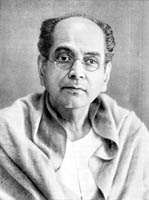Abanindranath Tagore
BORN DIED EDUCATION QUALIFICATIONS SELECTED SOLO EXHIBITIONS SELECTED GROUP EXHIBITIONS SELECTED POSTHUMOUS EXHIBITIONS ABOUT THE ARTIST Born on August 7, 1871, at Jorasanko, the Tagore family residence, Abanindranath was the son of the artist Gunendranath Tagore. Abanindranath was educated at Sanskrit College, Calcutta. At the age of 20, he came across an album of Mughal and Pahari miniatures. He was greatly influenced by the fine decorative lines, vibrant colors and the power behind the canvas. Abanindranath was not a trained painter; All of his creations were his work as a self-taught artist. Although he entered the art world at an older age, he matured as a painter very early, absorbing ideas and developing his own work. His work has the great delicacy of feeling, unity of concept and a very sensitive range of color, tone, texture and poetic depth. He was soon considered the father of modern Indian art. This was probably the influence and training he received from the Italian artist Signior Chilardi, deputy director of the Government Art School, and the English painter Charles Palmer. Abanindranath turned to traditional Indian art only in 1895 and for ten years experimented with the Rajput style of painting. During this period he created a Radha and Krishna serial and also worked on the Krishna Leela episode between 1895 and 1905. The year 1905 has a great significance in the life of Abanindranath. It was at this time that he came into contact with the Japanese artists Tikan and Hesida and from them he learned the watercolor wash method. That same year, he laid the foundation of the Bengali School of Indian painting, where he eventually led the revitalization movement in the field of modern Indian painting with the help of a group of disciples A K Haldar, K N Majumdar, S N Gupta and a host of others. He considered art as a work that was linked in a sustained and continuous manner. His work was a mix of traditionalism and innovation. More likely because, when he arrived on the art scene, Indian art was at a confusing stage. His goal was to compare nature in its transitory forms and produce an image of an object that was part, part sensual, both transposed into each other. But his vision of nature was always poetic, as was his personal form of expression. When art was replete with romanticism, Abanindranath established his anti-idealist stance by declaring that if art could realize perfect beauty, the whole spectacle would have ended long ago. Abanindranath's talent with the brush and his unorthodox teaching methods earned him a reputation at the Government College of Art, Calcutta, where he joined as vice-principal under Dr. E. B. Havell. Havell himself was enamored of the richness of India's artistic tradition and pioneered the rejection of the rigors of learning European art in Indian art schools. He strongly favored Indian art that would emerge from a deeply rooted national feeling. Nicholas Roerich observed the glorious development of Indian art and explained the importance of Abanindranath as a beacon of power, as a guru of an entire school of art. He is also known to have said the following about Abanindranath Tagore: The emotions contained in his paintings in their genuine imaginative rhythm are full of poetic symbolism. His paintings seem to say to his master: we sing to his hand and to his heart. In addition to his early involvement as vice-principal of the Government College of Arts and Crafts, Calcutta, he founded the Indian Society of Oriental Art, Calcutta (1907); Bageswari Professor of Fine Arts, University of Calcutta (1923-24). He died on December 5, 1951. His works are declared a National Art Treasure. The largest number of Abanindranath's paintings (more than 500) are part of the collection of the Rabindra Bharati Society in Jorasanko, Calcutta. Abanindranath's paintings were exhibited in London and Paris in 1913, followed by another international exhibition in Japan in 1919. His appreciative audience included Rodin and Rothenstein. Abanindranath's influence on modern Indian art is profound and under him, a new generation of painters (Nandalal Bose, Asit Halder, Kshitindranath Majumder and Jamini Roy) brought about a renaissance of Indian art. Notification - We do not usually display Abanindranath Tagore's work, only send it to private art collectors and interested art buyers.
7 August, 1871
5 December, 1951
1907 Taught at the Indian Society of Art (ISOA), Calcutta.
1905 Taught at the Government School of Art (GSA), Calcutta.
He studied at the Government College of Arts and Crafts, Calcutta.
Private Tutors, Olinto Gilhardi and Charles Palmer
1928 Athene Gallery, organized by James Cousins, Geneva, Switzerland.
1924 Traveling exhibition, United States, organized by the American Federation of Art and the Indian Society of Oriental Art.
1915-16 Indian Society of Oriental Art, Calcutta and Indian Young Men's Association, Chennai
1914 22nd Exhibition of the Societe des Peintres Orientalistes Francois, Grand Palais, Paris, traveling to Belgium, Holland and the Imperial Institute, England
1911 Festival of Empire, organized by the Indian Society of Oriental Art, for the Coronation of George V, Crystal Palace, England.
1911 Indian Society of Oriental Art (ISOA), United Provinces Exhibition, Allahabad.
1908,10,12 Inaugural Exhibition, Indian Society of Oriental Art (ISOA), Calcutta
1900 American Federation of Arts, United States.
1900 Government School of Arts and Crafts Exhibition, Calcutta
2011 Ethos V Indian Art through the Lens of History (1900 to 1980), Indigo Blue Art, Singapore
2011 Three Tagores Art Circle, on the eve of the 150th birth anniversary of Rabindranath Tagore at the National Gallery of Modern Art (NGMA), New Delhi
2009 Indian Art after Independence Selected works from the collections of Virginia and Ravi Akhoury and Shelley and Donald Rubin, Emily Lowe Gallery, Hempstead
2009 In Search of the Vernacular, Aicon Gallery, New York
2003 Demonstrations, organized by Delhi Art Gallery, World Trade Centre, Mumbai and Delhi Art Gallery, New Delhi.
1996 Exhibition of Abanindranath's work, Nandan Gallery, Santiniketan, Kolkata.
Barman Arts Online


